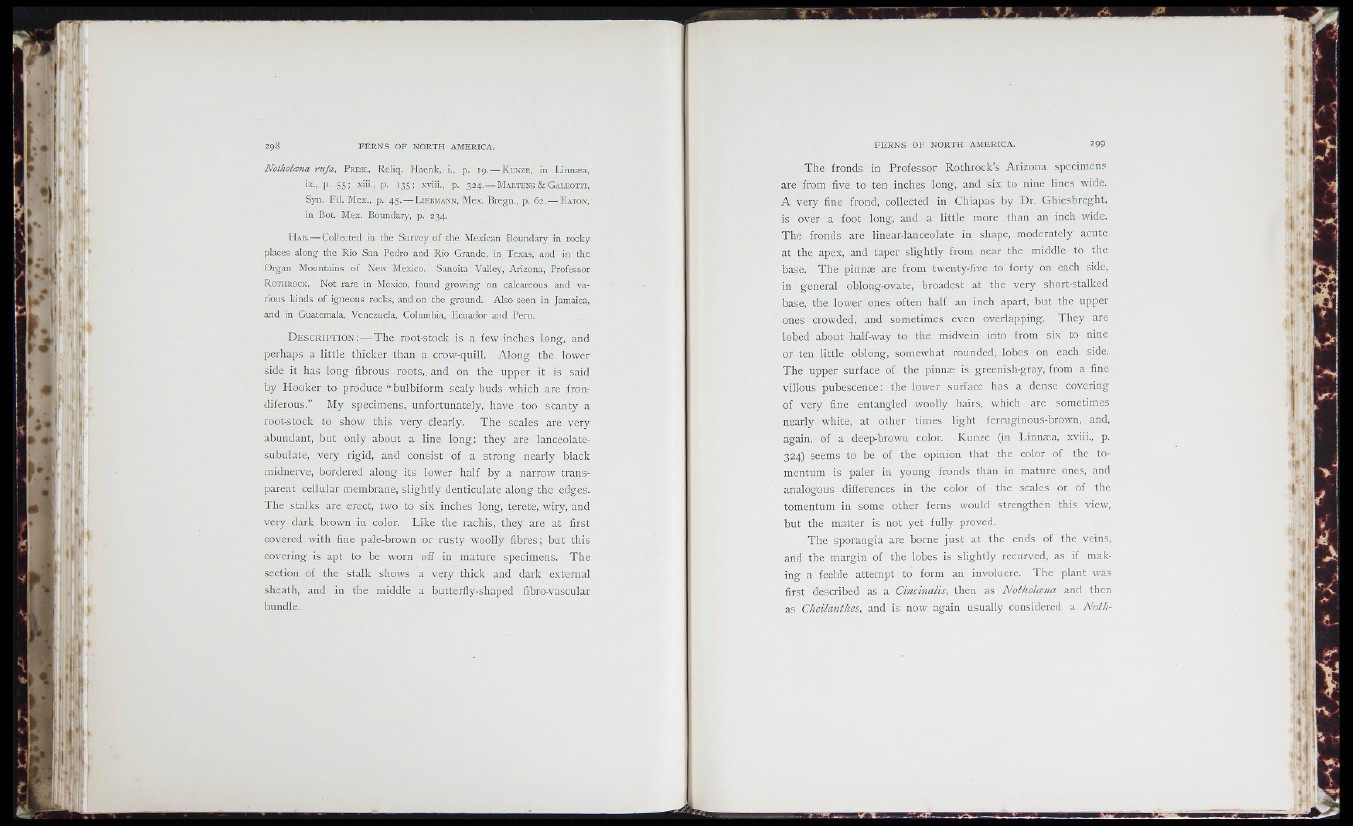
■ J
ü
' !
I
» - i ] " '■ ii :
í :
f
i i |
f
Notholcsna rufa, P r e s l , Reliq. Haenk, i., p. 19. — K u n z e , in Linnsa,
ix., p. 55; xiii., p. 13 5 ; xviii., p. 324.— M a r t e n s & G a l e o t t i ,
Syn. Fil. Mex., p. 45 .—'L i e b m a n n , Mex. Bregn., p. 62. — F a t o n ,
in Bot. Mex. Boundary, p. 234.
H a b . — Collected in the Survey of the Mexican Boundary in rocky
places along the Rio San Pedro and Rio Grande, in Texas, and in the
Organ Mountains of New Mexico. Sanoita Valley, Arizona, Professor
R o t h r o c k . Not rare in Mexico, found growing on calcareous and various
kinds of igneous rocks, and on the ground. Also seen in Jamaica,
and in Guatemala, Venezuela, Columbia, Fcuador and Peru.
D e s c r i p t io n : — The root-stock is a few inches long, and
perhaps a little thicker than a crow-quill. Along the lower
side it has long fibrous roots,, and on the upper it is said
by Hooker to produce‘‘ bulbiform scaly buds which are fron-
diferous.” My specimens, unfortunately, have too scanty a
root-stock to show this very clearly. The scales are very
abundant, but only about a line long: they are lanceolate-
subulate, very rigid, and consist of a strong nearly black
midnerve, bordered along its lower half by a narrow transparent
cellular membrane, slightly denticulate along the edges.
The stalks are erect, two to six inches long, terete, wiry, and
very dark brown in color. Like the rachis, they are at first
covered with fine pale-brown or rusty woolly fibres; but this
covering is apt to be worn off in mature specimens. The
section of the stalk shows a very thick and dark external
sheath, and in the middle a butterfly-shaped fibro-vascular
bundle.
The fronds in Professor Rothrock’s Arizona specimens
are from five to ten inches long, and six to nine lines wide.
A very fine frond, collected in Chiapas by Dr. Ghiesbreght,
is over a foot long, and a little more than an inch wide.
The fronds are linear-lanceolate in shape, moderately acute
at the apex, and taper slightly from near the middle to the
base. The pinnæ are from twenty-five to forty on each side,
in general oblong-ovate, broadest at the very short-stalked
base, the lower ones often half an inch apart, but the upper
ones crowded, and sometimes even overlapping. They are
lobed about half-way to the midvein into from six to nine
or ten little oblong, somewhat rounded, lobes on each side.
The upper surface of the pinnæ is greenish-gray, from a fine
villous pubescence: the lower surface has a dense covering
of very fine entangled woolly hairs, which are sometimes
nearly white, at other times light ferruginous-brown, and,
again, of a deep-brown color. Kunze (in Linnæa, xviii., p.
324) seems to be of the opinion that the color of the tomentum
is paler in young fronds than in mature ones, and
analogous differences in the color of the scales or of the
tomentum in some other ferns would strengthen this view,
but the matter is not yet fully proved.
The sporangia are borne just at the ends of the veins,
and the margin of the lobes is slightly recurved, as if making
a feeble attempt to form an involucre. The plant was
first described as a Cincinalis, then as Notholæna and then
as Cheilanthes, and is now again usually considered a Noth-
\
\
1 ,